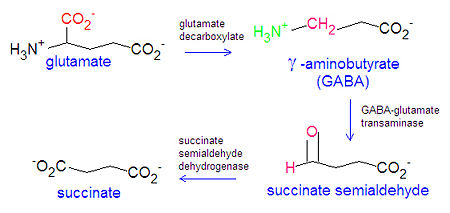Gamma-aminobutyric acid: Difference between revisions
imported>Robert Badgett m (Gamma aminobutyric acid moved to Gamma-aminobutyric acid: To be in line with National Library of Medicine spelling which will also let it better linked within CZ) |
imported>Robert Badgett No edit summary |
||
| Line 3: | Line 3: | ||
'''Gamma aminobutyric acid''' (GABA) or <math>\gamma</math>-aminobutyrate, is an inhibitory transmitter in the central nervous system. It is produced from the [[amino acid]] glutamate through the action of the enzyme [[glutamate decarboxylase]], and is inactivated by degradation to [[succinate]] in a two step mechanism involving the enzymes [[GABA-glutamate transaminase]] and [[succinate semialdehyde dehydrogenase]]. | '''Gamma aminobutyric acid''' (GABA) or <math>\gamma</math>-aminobutyrate, is an inhibitory transmitter in the central nervous system. It is produced from the [[amino acid]] glutamate through the action of the enzyme [[glutamate decarboxylase]], and is inactivated by degradation to [[succinate]] in a two step mechanism involving the enzymes [[GABA-glutamate transaminase]] and [[succinate semialdehyde dehydrogenase]]. | ||
==Role in clinical pharmacology== | |||
===Gamma-aminobutyric acid (GABA) agonists=== | |||
[[Gamma-aminobutyric acid]] (GABA) the major inhibitory neurotransmitter in the central nervous system.<ref name="isbn0-07-145153-6">{{cite book |author=Katzung, Bertram G. |title=Basic and clinical pharmacology |publisher=McGraw-Hill Medical Publishing Division |location=New York |year=2006 |pages= |isbn=0-07-145153-6 |oclc= |doi=}}</ref> Drugs that increase the effect of GABA are called GABAergic. | |||
Many sedatives work by increasing receptiveness of GABA<sub>A</sub> receptors. | |||
====Barbituates==== | |||
[[Barbituates|Barbituates]] are GABAergic by increasing receptiveness of the GABA<sub>A</sub> receptors. Barbituates do this by increasing the duration of openings of channels in the cell membrane.<ref name="isbn0-07-145153-6"/> | |||
* Phenobarbital | |||
====Benzodiazepines==== | |||
Benzodiazepines are also GABAergic by increasing receptiveness of the GABA<sub>A</sub> receptors. However, benzodiazepines do this by increasing the frequency of openings of channels in the cell membrane.<ref name="isbn0-07-145153-6"/> | |||
[[Benzodiazepine]] receptors are BZ<sub>1</sub> and BZ<sub>2</sub>. | |||
=====Non-selective agonists===== | |||
* [[Diazepam]] ([[Valium]]) | |||
=====BZ<sub>1</sub> selective agonists===== | |||
* [[Zaleplon]] | |||
* [[Zolpidem]] | |||
Revision as of 22:09, 12 February 2009
Gamma aminobutyric acid (GABA) or -aminobutyrate, is an inhibitory transmitter in the central nervous system. It is produced from the amino acid glutamate through the action of the enzyme glutamate decarboxylase, and is inactivated by degradation to succinate in a two step mechanism involving the enzymes GABA-glutamate transaminase and succinate semialdehyde dehydrogenase.
Role in clinical pharmacology
Gamma-aminobutyric acid (GABA) agonists
Gamma-aminobutyric acid (GABA) the major inhibitory neurotransmitter in the central nervous system.[1] Drugs that increase the effect of GABA are called GABAergic.
Many sedatives work by increasing receptiveness of GABAA receptors.
Barbituates
Barbituates are GABAergic by increasing receptiveness of the GABAA receptors. Barbituates do this by increasing the duration of openings of channels in the cell membrane.[1]
- Phenobarbital
Benzodiazepines
Benzodiazepines are also GABAergic by increasing receptiveness of the GABAA receptors. However, benzodiazepines do this by increasing the frequency of openings of channels in the cell membrane.[1]
Benzodiazepine receptors are BZ1 and BZ2.
Non-selective agonists
BZ1 selective agonists
- ↑ 1.0 1.1 1.2 Katzung, Bertram G. (2006). Basic and clinical pharmacology. New York: McGraw-Hill Medical Publishing Division. ISBN 0-07-145153-6.

